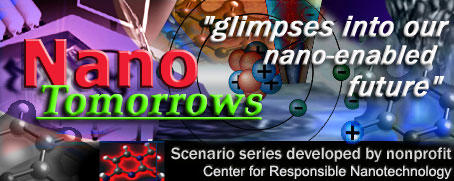
The nonprofit Center for Responsible Nanotechnology (CRN) has released a series of scenarios depicting various versions of a near future nanotechnology world into which transformative manufacturing concepts may emerge. Across eight separate storylines, an international team of policy, technology, and economic specialists organized by CRN imagined in detail a range of plausible, challenging events – from pandemics to climate crises to international conflicts – to see how they might affect the development of advanced nanotechnology over the next 15 years.
Scenario 1: Secret Military Development When the Democratic Party retakes the White House in 2009, most observers expect that how the new President deals with the implosion of Iraq and the ongoing "war on terror" will dominate the headlines over the course of her term in office. These observers are correct – but not for the reasons they believe. Terrorism and war would certainly remain vital national issues for the new administration, but they are overshadowed by the emergence of a provocative new tool for both the U.S. and its adversaries.
Scenario 2: Positive Expectations When the first "late beta" version of RepRap – the "replicating rapid-prototyper" – is released in early 2008, critics have a field day. It's slow. It's clumsy-looking. It can't actually replicate itself without adding a few key commercial parts. But where critics see an ugly duckling, design students, DIY hackers, and open source enthusiasts see a swan-in-the-making. By the summer, dozens of novel fabber projects emerge (some forked from RepRap, but most based on original designs), and by the fall, some have actually produced devices that an adventurous home user could play with. Forward-looking strategists at mega-retailers and mass manufacturers feel a distinct chill run up their collective spine.
Scenario 3: Negative Drivers A story of death and redemption in three acts.
Scenario 4: Presidential Commission Presidential Commission on Molecular Manufacturing. Analysis: Origins of the Present Crisis
Scenario 5: And Not a Drop to Drink Water is crucial to the tiny island nation of Singapore. Surrounded by the salty sea, they get 50 percent of their potable water from rainfall and must import the other 50 percent. As of 2007, Singapore had a water purchase agreement with Malaysia, acquiring fully half of their nation's water supply through a dual pipeline running across the Straits of Johor. The Malaysia-Singapore agreement was due to run out in 2011, however, and an intractable disagreement over the price of water had caused negotiations to stall.
Scenario 6: A Goal Postponed The middle of the first decade of the millennium saw a slow shift toward acceptance of molecular manufacturing. Not only its proponents, but unaffiliated scientists as well, began to acknowledge that the idea of molecular machines building molecular machines might be worth pursuing. The supporters of the approach began to draw a cautious breath of relief. By 2007, at least one group (the Nanofactory Collaboration) was working toward atom-by-atom fabrication of diamond, a company with a history of successful lab research (Zyvex) was working toward atomically precise silicon shapes, and DNA technology was making great strides forward.
Scenario 7: Newshound Notebook Excerpts, 2013-2018
Scenario 8: Breaking the Fever Global warming skeptics used to claim that the models climatologists used were wrong. Much to everyone's surprise, they were right. Unfortunately, they were right in the wrong way: the models weren't wrong because they over-stated the impact of global warming; they were wrong because they so severely under-stated it.
Note: These scenarios are not predictions, and do not represent outcomes desired by the Center for Responsible Nanotechnology. CRN intends the scenarios to provide a springboard for discussion of molecular manufacturing policies and societal responses. While each scenario can be understood individually, the real value of the process comes from the comparison of multiple scenarios. A strategic response that appears robust in one scenario may be dangerous in another; an organization, community, or polity using these scenarios to consider how to handle the emergence of molecular manufacturing should strive for responses that are viable across multiple scenarios. Finally, the numbering of the scenarios has nothing to do with importance or priority -- it's a simple reflection of the order in which they were completed.
